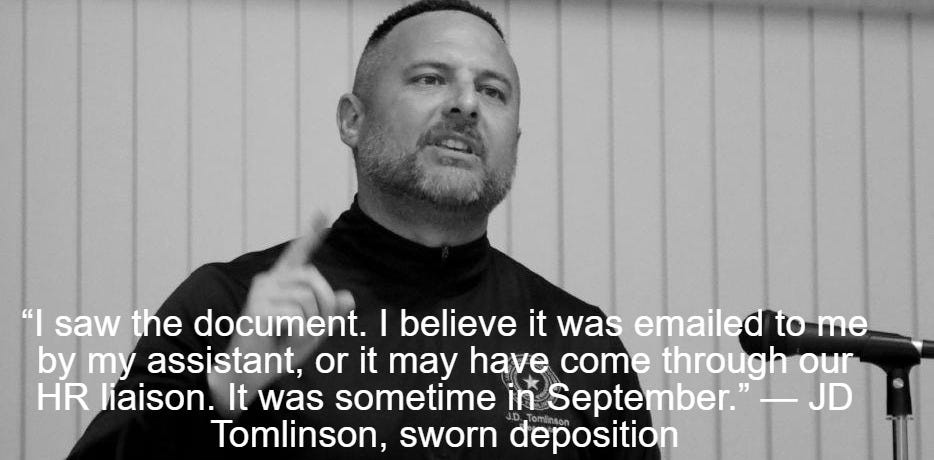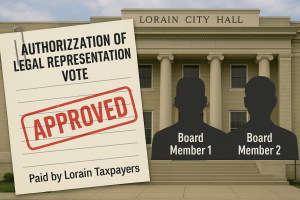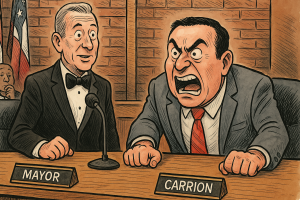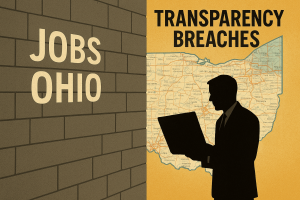Episode 4: Under Seal – What the Prosecutor Knew, When He Knew It, and How He Kept It Quiet

Inside JD Tomlinson’s Sworn Deposition and the Silencing of a Scandal
May 01, 2025
By Aaron Knapp | Lorain Politics Unplugged
⚖️ Legal Disclaimer
All quotes in this report are taken directly from the sworn deposition of Lorain County Prosecutor JD Tomlinson and accompanying public records.

Thanks for reading Aaron’s Substack! Subscribe for free to receive new posts and support my work.
I. First Contact: When Tomlinson Learned of the Complaint
In sworn testimony, Lorain County Prosecutor JD Tomlinson admitted that he learned of Jennifer Battistelli’s formal EEOC complaint weeks before the settlement was processed and approved. His knowledge wasn’t speculative—it was firsthand. Under questioning, he stated that he saw the complaint “around the time it was filed,” placing his awareness well before October 2022, when the $100,000 payment was quietly processed as a requisition.
“I saw the document. I believe it was emailed to me by my assistant, or it may have come through our HR liaison. It was sometime in September.” — JD Tomlinson, sworn deposition
That answer directly contradicts the timeline presented by Commissioners David Moore and Michelle Hung, who testified that the Board was never made aware of the complaint prior to the settlement vote. Tomlinson, by contrast, had already read the allegations in detail. The complaint, marked as Relator’s Exhibit 1, accuses Tomlinson of using his public office to coerce Battistelli into a romantic relationship under threat of professional retaliation. It also accuses him of physical misconduct.
Tomlinson did not deny seeing the complaint. Nor did he deny its explosive contents. Instead, he attempted to downplay them. “I did not believe the allegations were credible,” he said. “We considered them politically motivated.” Yet he took no legal steps to challenge them. He did not issue a public denial. He did not refer the matter for independent investigation. And he did not bring it to the attention of the Board of Commissioners.
Rosenbaum pressed him: “Did you ever bring this document to the commissioners for their review prior to the payment?” Tomlinson replied:
“No. It was handled within our office. I did not see it as necessary for them to review it at that time.”
That response stunned observers and legal experts alike. The EEOC complaint wasn’t a private grievance—it was a legal threat against a sitting public official. The settlement would ultimately involve taxpayer funds. But Tomlinson made the decision to keep the Board in the dark. In fact, the first time some commissioners saw the complaint was months later, after a court ordered its release in response to a public records lawsuit.
“Was there any formal discussion with the Board prior to the payment being authorized?” Rosenbaum asked. Tomlinson responded:
“Not to my knowledge. I believe that was coordinated through civil counsel.”
That “civil counsel” was Assistant Prosecutor Dan Petticord, who—according to his own deposition—was advising Tomlinson directly, not the Board. Petticord also failed to show the complaint to the commissioners or recommend an executive session. As a result, elected officials were asked to vote on a six-figure settlement without ever seeing the document that justified it.
Tomlinson admitted under oath that he had the ability to escalate the matter. He could have requested independent legal analysis. He could have held a press conference or referred the complaint to the Ohio Ethics Commission. He did none of those things. Instead, he said:
“We believed the fastest way to resolve this was through a financial agreement.”
“So you chose to settle and suppress rather than defend the allegations publicly?” Rosenbaum asked.
“We chose to protect the office from distraction.” — JD Tomlinson
That line may be the most revealing of all. The priority was not transparency. It was containment. Tomlinson saw the complaint, understood the threat, and moved to seal it off—first by bypassing outside review, then by orchestrating a quiet settlement, and finally by claiming that none of it required public explanation.
And all of it happened in obscurity—until a lawsuit forced its release. Though the settlement itself was technically a public record, no one in the administration volunteered its existence. It remained buried until compelled by court order.

II. Ghosting the Commissioners
If JD Tomlinson had truly believed in transparency, his first call would have been to the Lorain County Board of Commissioners. But according to both his own testimony and that of Michelle Hung, that call never came. Tomlinson did not initiate a briefing. He did not share the EEOC complaint. He did not appear in executive session. Instead, he relied on silence, omission, and vague intermediaries to get his settlement through.
“I never received anything from JD. Not an email, not a call, not even a heads-up,” Hung stated in her deposition.
This silence wasn’t due to lack of opportunity. Tomlinson was in regular contact with key figures across the county government, including Assistant Prosecutor Dan Petticord and fiscal staff. Yet at no point did he attempt to ensure the commissioners—the legal body responsible for authorizing payments—understood what they were voting on. The only explanation he offered was that it was “handled internally.”
“Handled by who?” Rosenbaum asked.
“By our office. The Prosecutor’s Office.” — JD Tomlinson
Tomlinson’s insistence that the matter was “internal” fails under scrutiny. The $100,000 payout was made using public funds. The settlement agreement required signatures. The commissioners were legally accountable for approving that expenditure. And yet, Tomlinson took no steps to make sure they were informed. He never even attended the meeting where the requisition was approved.
His failure to communicate left commissioners like Hung and Riddell dependent on Petticord, who himself admitted he was advising Tomlinson—not the Board. Hung testified that when she asked questions about the settlement, she was deflected or ignored. Petticord told her the appointing authority had approved it and the commissioners were obligated to pay.
Tomlinson’s silence also extended to the media and the public. No press release was issued. No investigation was launched. No statement was made to acknowledge the payout or its underlying allegations. For months, the public had no idea the complaint even existed. It was only after Rosenbaum’s public records lawsuit and a judge’s order that the truth emerged.
In sworn deposition, Tomlinson admitted he knew the commissioners had not been shown the complaint. When asked if he saw any problem with that, he replied:
“It was a personnel matter. I believed it was confidential and best resolved quietly.”
That reasoning rings hollow. Personnel complaints involving workplace harassment or misconduct by public officials are routinely reviewed in executive session. Confidentiality does not mean concealment from decision-makers. By cutting the commissioners out of the loop, Tomlinson ensured that no oversight could take place before public money changed hands.
This wasn’t a miscommunication. It was a calculated decision to keep the people with the legal authority to ask questions from even knowing there were questions to ask. And for a prosecutor—someone sworn to uphold the law—that decision may have permanently eroded his credibility.

III. The “Strategic Silence” Around the Payout
By the time the $100,000 settlement appeared on the commissioners’ agenda, JD Tomlinson had already executed a plan that relied not just on obscurity—but on momentum. Once fiscal staff received the go-ahead from Assistant Prosecutor Dan Petticord, the payment moved fast. It was categorized as a legal services expenditure, stripped of identifying context, and added to the agenda as a late requisition.
Michelle Hung testified that she only learned what it was minutes before the meeting. “It was listed as a generic legal bill,” she said. “I had to send my assistant to go ask for the actual settlement agreement.” The speed and vagueness of the process were no accident. By not discussing the complaint openly, Tomlinson ensured there’d be no executive session, no deep dive, and no delay.
“Did you take any steps to make sure commissioners were properly briefed?” Rosenbaum asked.
“I assumed civil counsel had done that.” — JD Tomlinson
That assumption, according to Tomlinson’s own deposition, was never verified. He did not follow up. He did not ask Petticord to schedule an executive session. He did not personally provide any documents to the Board. He let the requisition go forward with a label that concealed its true purpose.
When asked if that concealment was intentional, Tomlinson deflected. “It was labeled as legal because it involved a legal matter,” he said. But no litigation had been filed. There was no case number. There had been no legal proceeding. The only document was the EEOC complaint—which Tomlinson and Petticord kept to themselves.
The urgency, however, came from elsewhere. Relator’s Exhibit 7—a contemporaneous email—shows that Battistelli’s attorney, Jack Moran, told county officials the complaint would be filed with the EEOC if payment wasn’t scheduled by October 17. That email was sent on October 13. Within hours, Petticord replied: “Just found out I can do this as a requisition.” The message was clear: keep it off the public radar, and pay it fast.
That email chain alone undermines any claim that this was routine business. It wasn’t. It was a deliberate effort to avoid public disclosure. No one alerted CORSA, the county’s insurance consortium, which may have triggered an independent investigation. Instead, Tomlinson worked through his own office and orchestrated a direct payout—bypassing the usual scrutiny and avoiding any questions a third party might raise.
Hung was clear about how unusual this was. “Every other settlement I’ve seen, we discussed in executive session,” she said. “This was the only one that wasn’t.” When asked why CORSA wasn’t involved, she stated plainly: “Because they didn’t want it investigated.”
Tomlinson never denied that either. He simply said, “I believed it was within the office’s discretion to resolve the matter.” But his deposition revealed no policy, statute, or justification that explained why the standard procedures were skipped. There was no memo, no legal opinion, and no written guidance.
“Do you think a reasonable commissioner could have made an informed vote without seeing the complaint?” Rosenbaum asked.
“They relied on fiscal and legal staff,” Tomlinson said.
“That’s not what I asked.”
“Then no,” Tomlinson finally replied.
That brief admission was buried in pages of deflection, but it confirms what Hung and others testified to: the complaint was intentionally withheld. The commissioners were not just uninformed—they were kept uninformed.
Hung also revealed that the settlement was not even brought to the Board’s attention by Tomlinson’s office—it appeared on the requisition sheet as an afterthought. “It was snuck in there,” she said. “No one volunteered that it was tied to JD.”
The payout’s timing also appeared calculated. It occurred during a budget cycle, when county leadership was distracted by larger financial considerations. “They timed it so it wouldn’t be noticed,” Hung said. “That’s not just unethical. That’s coordinated deception.”
“Do you believe it would have passed had the commissioners seen the complaint first?” Rosenbaum asked.
Tomlinson paused. “I can’t speculate on that.”
But of course, he already had. The silence wasn’t an accident. It was a strategy.
IV. No Mistake – Concealment by Design
What happened in the Battistelli payout wasn’t bureaucratic error—it was tactical omission. JD Tomlinson had the opportunity and legal obligation to inform the commissioners about a complaint implicating himself. Instead, he relied on the very ambiguity of internal processes to shield the facts and himself.
“I believed it was best handled through civil channels,” Tomlinson said in deposition. But when asked if there was any written justification for bypassing the Board, he answered, “No, it was an internal matter.”
That phrase—“internal matter”—appears repeatedly in Tomlinson’s testimony. It’s not a legal standard. It’s a rhetorical firewall. He used it to deflect responsibility from every stage of the process: not notifying the Board, not referring the complaint to an outside agency, not involving CORSA, and not disclosing the nature of the payout.
But the stakes of the complaint were not internal. The allegations in the EEOC document described coercive conduct in a public office, misuse of power, and the threat of retaliation. If substantiated, those charges would constitute civil rights violations and grounds for removal from office. And they were settled—using taxpayer money—with zero scrutiny.
“There was a duty to inform us,” Michelle Hung said. “He knew. Petticord knew. They made sure we didn’t.”
In the Sheriff’s Department’s 558-page document log, Jennifer Battistelli reportedly stated that JD Tomlinson told someone to “talk to Dave”—a reference to Commissioner David Moore—about ensuring her payment was processed. This was not hands-off management. This was coordination.
The requisition process itself was altered to accommodate the payout. According to Hung, there were two versions of the requisition sheet sent out that week. The second one—bearing the Battistelli payment—was slipped in at the last minute. “We’d already reviewed the week’s items,” she said. “This came in after the fact. No one told me why.”
And the terminology used? “Professional services.” That phrase, according to multiple officials, had never been used to describe an EEOC or sexual misconduct settlement. “They hid it in plain sight,” Hung testified. “If I hadn’t asked for it directly, we’d never have known.”
The deception was compounded by silence. Tomlinson never issued a public explanation. His office never corrected the record. Commissioners were left to discover, on their own, the nature of what they had approved. “That’s why I voted no on future legal reimbursements,” Hung said. “They lost our trust.”
“In your view, was the decision to withhold the complaint from commissioners justifiable?” Rosenbaum asked. “No,” Tomlinson said. “Not if you’re asking about what’s ethically right.”
That rare admission—buried in hundreds of pages of equivocation—underscores what every part of this scandal reveals: the concealment was deliberate, and it served to protect one person above all others—JD Tomlinson.
He saw the complaint. He read the accusations. He had a chance to come clean. Instead, he orchestrated silence. That silence became the strategy. And that strategy is what allowed this misconduct to unfold—unnoticed and unchallenged—until now.

V. Patterns, Power, and the Public’s Right to Know
Episode 4 has laid bare not just a single act of concealment—but a method, a structure, and a pattern. JD Tomlinson’s conduct was not a lapse in judgment. It was part of a deliberate system of evasion. A complaint arrived. A six-figure payout followed. And at every stage, those with the power to ask questions were kept in the dark.
He could have called a meeting. He could have involved CORSA. He could have issued a public statement or allowed the commissioners to review the complaint before signing off on taxpayer funds. Instead, he engaged in legal compartmentalization—pushing all accountability into an “internal matter” while publicly pretending nothing had happened.
The public wasn’t just ignored. It was deliberately excluded. The complaint described coercion. The settlement silenced it. The commissioners never voted knowingly. The citizens never got answers. And the only person who walked away untouched was the man accused.
This is what happens when a prosecutor prioritizes protection over principle. It wasn’t just JD Tomlinson who failed. It was the entire chain of governance that followed his lead—or failed to stop him. And it underscores a larger truth: unchecked power does not merely corrupt. It conceals.
For months, this story lived in shadows. Depositions changed that. The testimony of Michelle Hung, the evasions of Dan Petticord, and Tomlinson’s own admissions under oath now give the public a full record. What they do with it is another matter.
Every commissioner who claims ignorance must now reckon with why. Every staffer who helped process this payout must answer whether they knew what they were doing. Every voter must ask if this is the kind of law enforcement leadership Lorain County can afford to keep.
There are still more questions: Why wasn’t this referred to an outside investigator? Why did the county pay for Tomlinson’s personal legal defense? Why did the Board never receive a formal ethics opinion?
Those answers are coming. The next installment turns to what didn’t happen—and what that silence really cost.
Author’s Opinion: When the Prosecutor Becomes the Problem
There are few jobs more sacred in a democracy than that of a prosecutor. The power to charge, to investigate, to compel accountability—that authority must be wielded with discipline, humility, and above all, transparency. JD Tomlinson abandoned all three.
He did not stumble into concealment. He orchestrated it. He did not hesitate out of caution. He calculated silence as a defense. And the result was a settlement executed in shadows, an EEOC complaint buried from view, and a Board of Commissioners stripped of its oversight power at the most critical moment.
Even when given the opportunity to tell the truth under oath, Tomlinson spoke in circles. He evaded. He deflected. He leaned on the vague language of “internal matters” and let his assistant prosecutor carry the bag. But his fingerprints are everywhere—in the timing, in the language used, in the emails, and in the decisions that followed.
He made a choice to protect himself instead of the public. That alone should have disqualified him from the office he held—and voters finally made sure it did.
Lorain County residents demanded better—and they got it. The voters removed Tomlinson, a clear rejection of his self-serving conduct and the secrecy that defined his tenure. They deserve a justice system that acts when allegations arise—not one that pays to silence them.
“Not if you’re asking about what’s ethically right,” Tomlinson said. That was the only honest thing he said that day.
And that’s why this series will continue.
Next Time in Episode 5: The Ethics Opinion That Never Came
Commissioner Michelle Hung asked. She was told to call JD’s lawyer.
Why didn’t the Prosecutor’s Office seek an independent legal opinion? Why was a settlement involving criminal allegations and a six-figure payout never brought before a judge? And how did the ethics complaint against Commissioner David Moore disappear while his votes stayed conveniently aligned?
Episode 5: “The Legal Firewall That Failed” – Coming Soon.
📄 Final Legal Disclaimer
This article is based on sworn deposition transcripts, public records, and firsthand testimony from involved officials. All statements attributed to JD Tomlinson, Michelle Hung, and other public officials are verified through official documentation. Allegations referenced in this series are presented as part of ongoing investigative reporting into matters of public concern.**





